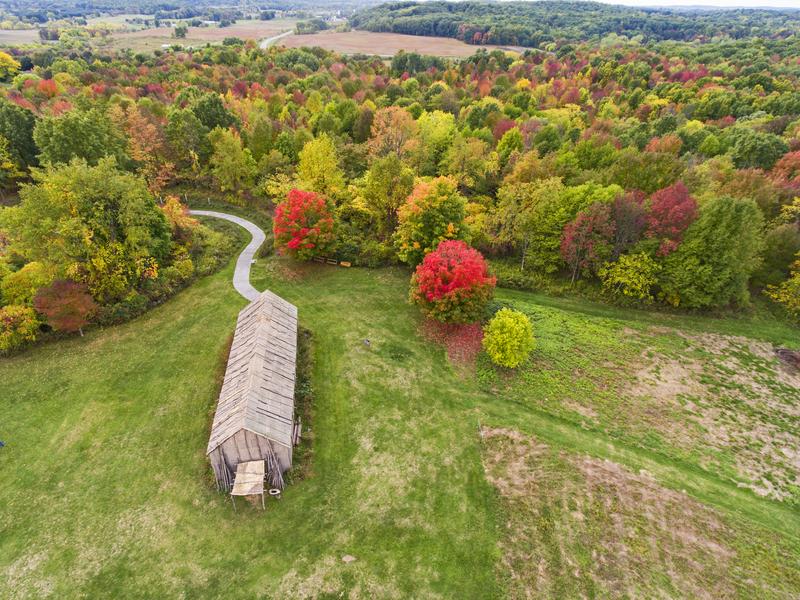The People of the Longhouse: The Iroquois League
By | September 15, 2019

In the northeast of what was to be the United States an American Indian people united into one of the most powerful Native American coalitions in North America.
It was so influential that many scholars believe that the Iroquois Confederacy or League may have influenced the development of American democracy.

The Great Peacemaker
According to tradition, before the European contact tribes of Native Americans just south of the Great Lakes, mostly based in today’s New York State but extending into Canada and Pennsylvania were frequently at war. These tribes, the Senecas, Mohawks, Oneidas, Onondagas, and Cayugas, had a shared language and cultural heritage but there were continual violent squabbles and wars over territory.
A figure known as the Great Peacemaker appeared on the scene. Not much is known of the Great Peacemaker, not even his proper name. Instead, he is reverentially referred to by a spiritual name Deganawida -- which signifies “two rivers flowing together” and many other names, too. But the most common is the Great Peacemaker. He can best be described as a semi-mythological prophet-like figure who preached peace between the warring nations. His argument was that if the tribes united then they could fend off attacks and achieve prosperity.

Hiawatha
The Great Peacemaker had a major handicap -- he stammered. Traditional Indian societies were steeped in oral tradition and to have a speech impediment was a major problem. However, he found an ally in the Onondaga brave, Hiawatha, and through diplomacy established the Haudenosaunee Nation or People of the Longhouse. These people, however, came to be best known as the Iroquois -- a name of French origin with an unsure etymology.
There are alternate versions of this tale which has the Great Peacemaker as simply appearing in a vision to Hiawatha. Also, many modern scholars do not believe that Hiawatha was a singular person, but rather represented an amalgam of many Iroquois leaders. Regardless, what was established as the Great Law of Peace which created the Iroquois League or Confederacy in either in 1190 or 1451. The great disparity in these dates is due to the Confederacy having been formed at a solar eclipse that matches those dates.

The Tree of Peace
The Great Law of Peace was not recorded in a written language per se -- the Iroquois did not have any. Rather they used symbols on wampum belts. This codified the structure of government.
The Iroquois were ruled by a Grand Council of Chiefs that were selected by Clan Mothers. This 50-person body was headed by one Chief of Chiefs with the first historically being Tadadaho of the Onondaga Nation who agreed to weld his tribe to the Confederacy in return for being Chief of Chiefs. Subsequent heads of the Grand Council were called Tadadaho in his honor. The symbol of the confederacy was the Eastern White Pine, what they referred to as the Tree of Peace or the Tree of Great Long Leaves.

The League in Action
Laws were passed only by unanimous consent of the Grand Council of Chiefs. If there was dissent then it was agreed that each tribe would establish its own policies. There was neither police nor army. In 1722, the Five Nations became six when the Tuscarora joined, which had migrated from the south.
The Confederacy was the most organized form of the Native American government. This resulted in the Iroquois becoming a regional powerhouse reaching a peak in the 17th century. There were probably never more than 12,000 people in all of the League. The relatively low population was one of the contributory causes for “Mourning Wars,” that is that when the Iroquois lost braves in raids and such, they would launch attacks on enemy tribes with the express purpose of abducting and adopting replacements. If replacements did not go along with their new role, they were likely to be executed.

Power
During the French and Indian War (1754-1763) the confederacy sided with the British and was probably decisive in helping them win the war. However, during the American War of Independence, the Iroquois League could not maintain the same cohesive front. By the mid-nineteenth century, the League had largely been disbanded and the Iroquois had been pushed out by the Americans. A great “What-If” in history is if Europeans had never come to North America, how powerful the Iroquois might have become. Some scholars believe that they had the capability of dominating the eastern seaboard.

Influence
Of more relevance is the debated impact of the Iroquois Confederacy on the development of the American republic. Some scholars argue that while the Founding Fathers had studied the political theories of Locke and Montesquieu, the Iroquois League was the only functioning republic in existence. These scholars contend that the ideas of practical individual freedom, checks, and balances, as well as the liberty of individual tribes (or states), deeply influenced the creation first of the Articles of Confederation and then the Constitution.
The problem, other scholars contend that there is simply no evidence that there was such influence and such theories are conjectural at best. Regardless, it seems that the idea of the League was well-known to the thirteen colonies and at the least provided inspirational osmosis for democracy in America.

